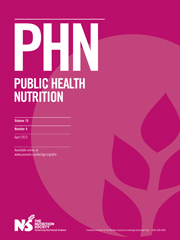Editorial
World Nutrition 2012 – a global Public Health Nutrition opportunity
-
- Published online by Cambridge University Press:
- 01 March 2012, p. 567
-
- Article
-
- You have access
- HTML
- Export citation
Monitoring and surveillance
Research paper
Prevalence of ocular signs and subclinical vitamin A deficiency and its determinants among rural pre-school children in India
-
- Published online by Cambridge University Press:
- 02 September 2011, pp. 568-577
-
- Article
-
- You have access
- HTML
- Export citation
Dietary habits of partly breast-fed and completely weaned infants at 9 months of age
-
- Published online by Cambridge University Press:
- 09 December 2011, pp. 578-586
-
- Article
-
- You have access
- HTML
- Export citation
Nutritional supplement use among Slovenian adolescents
-
- Published online by Cambridge University Press:
- 14 September 2011, pp. 587-593
-
- Article
-
- You have access
- HTML
- Export citation
Overweight among children decreased, but obesity prevalence remained high among women in South Africa, 1999–2005
-
- Published online by Cambridge University Press:
- 18 October 2011, pp. 594-599
-
- Article
-
- You have access
- HTML
- Export citation
Food intake in Slovenian adolescents and adherence to the Optimized Mixed Diet: a nationally representative study
-
- Published online by Cambridge University Press:
- 24 October 2011, pp. 600-608
-
- Article
-
- You have access
- HTML
- Export citation
Television viewing and variations in energy intake in adults and children in the USA
-
- Published online by Cambridge University Press:
- 09 November 2011, pp. 609-617
-
- Article
-
- You have access
- HTML
- Export citation
Assessment and methodology
Research paper
Validity of two short screeners for diet quality in time-limited settings
-
- Published online by Cambridge University Press:
- 23 August 2011, pp. 618-626
-
- Article
-
- You have access
- HTML
- Export citation
Assessing dietary intake during the transition to adulthood: a comparison of age-appropriate FFQ for youth/adolescents and adults
-
- Published online by Cambridge University Press:
- 20 September 2011, pp. 627-634
-
- Article
-
- You have access
- HTML
- Export citation
Validation of a semi-quantitative FFQ using food records as a reference in older women in the Kuopio Fracture Prevention Study (OSTPRE-FPS)
-
- Published online by Cambridge University Press:
- 29 November 2011, pp. 635-639
-
- Article
-
- You have access
- HTML
- Export citation
Validation of protein and potassium intakes assessed from 24 h recalls against levels estimated from 24 h urine samples in children and adolescents of Turkish descent living in Germany: results from the EVET! Study
-
- Published online by Cambridge University Press:
- 24 October 2011, pp. 640-647
-
- Article
-
- You have access
- HTML
- Export citation
Epidemiology
Research paper
Food insecurity, childhood illness and maternal emotional distress in Ethiopia
-
- Published online by Cambridge University Press:
- 02 August 2011, pp. 648-655
-
- Article
-
- You have access
- HTML
- Export citation
To what extent do weight gain and eating avidity during infancy predict later adiposity?
-
- Published online by Cambridge University Press:
- 18 October 2011, pp. 656-662
-
- Article
-
- You have access
- HTML
- Export citation
A bean-free diet increases the risk of all-cause mortality among Taiwanese women: the role of the metabolic syndrome
-
- Published online by Cambridge University Press:
- 07 September 2011, pp. 663-672
-
- Article
-
- You have access
- HTML
- Export citation
Is there any relationship between dietary patterns and depression and anxiety in Chinese adolescents?
-
- Published online by Cambridge University Press:
- 25 November 2011, pp. 673-682
-
- Article
-
- You have access
- HTML
- Export citation
Western and Mediterranean dietary patterns among Balearic Islands’ adolescents: socio-economic and lifestyle determinants
-
- Published online by Cambridge University Press:
- 08 September 2011, pp. 683-692
-
- Article
-
- You have access
- HTML
- Export citation
Magnesium intake and prevalence of metabolic syndrome in adults: Tehran Lipid and Glucose Study
-
- Published online by Cambridge University Press:
- 05 January 2012, pp. 693-701
-
- Article
-
- You have access
- HTML
- Export citation
Maternal intention to breast-feed and breast-feeding outcomes in term and preterm infants: Pregnancy Risk Assessment Monitoring System (PRAMS), 2000–2003
-
- Published online by Cambridge University Press:
- 22 September 2011, pp. 702-710
-
- Article
-
- You have access
- HTML
- Export citation
Review Article
Vitamin D, sun, sunbeds and health
-
- Published online by Cambridge University Press:
- 24 October 2011, pp. 711-715
-
- Article
-
- You have access
- HTML
- Export citation
Nutrition and health
Research paper
Serum retinol in 1–6-year-old children from a low socio-economic South African community with a high intake of liver: implications for blanket vitamin A supplementation
-
- Published online by Cambridge University Press:
- 23 August 2011, pp. 716-724
-
- Article
-
- You have access
- HTML
- Export citation



